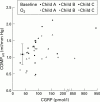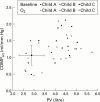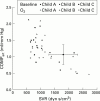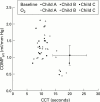High arterial compliance in cirrhosis is related to low adrenaline and elevated circulating calcitonin gene related peptide but not to activated vasoconstrictor systems
- PMID: 11413119
- PMCID: PMC1728353
- DOI: 10.1136/gut.49.1.112
High arterial compliance in cirrhosis is related to low adrenaline and elevated circulating calcitonin gene related peptide but not to activated vasoconstrictor systems
Abstract
Background and aims: Static and dynamic functions of the wall of large arteries are largely unknown in cirrhosis in vivo. The present study was undertaken to determine arterial compliance (COMP(art)) in relation to vasodilator and vasoconstrictor systems in patients with cirrhosis. In addition, vasoactivity was manipulated by inhalation of oxygen.
Study population and methods: In 20 patients with alcoholic cirrhosis and 12 controls we determined COMP(art) (stroke volume relative to pulse pressure), cardiac output, plasma volume, systemic vascular resistance, central circulation time, plasma catecholamines, renin activity, endothelin-1, and calcitonin gene related peptide (CGRP) at baseline and during oxygen inhalation.
Results: COMP(art) was significantly increased in cirrhotic patients compared with controls (1.32 v 1.06 ml/mm Hg; p< 0.05) and inversely related to plasma adrenaline levels (r=-0.53; p<0.02) but positively related to circulating levels of CGRP (r=0.58; p<0.01). No significant relation was found for plasma noradrenaline, renin activity, or endothelin-1. COMP(art) was positively related to plasma volume (r=0.50; p<0.02) and inversely to systemic vascular resistance (r=-0.69; p<0.001) and central circulation time (r=-0.49; p<0.02). During oxygen inhalation, COMP(art) decreased (-13%; p<0.005) and systemic vascular resistance increased (+10%; p<0.001) towards normal values without significant changes in mean arterial pressure. Plasma adrenaline (-16%; p<0.01) decreased and the relation to COMP(art) disappeared. The relation of COMP(art) to CGRP and circulatory variables remained unchanged.
Conclusion: Elevated arterial compliance in cirrhosis is related to low adrenaline, high CGRP, and systemic hyperdynamics but not to indicators of the activated vasoconstrictor systems (noradrenaline, renin, endothelin-1). Thus the altered static and dynamic characteristics of the wall of large arteries are intimately associated with circulatory and vasodilatory derangement in cirrhosis but biomanipulation indicates that the changes are, at least in part, reversible during isobaric conditions.
Figures





References
Publication types
MeSH terms
Substances
LinkOut - more resources
Full Text Sources
Research Materials
Miscellaneous
